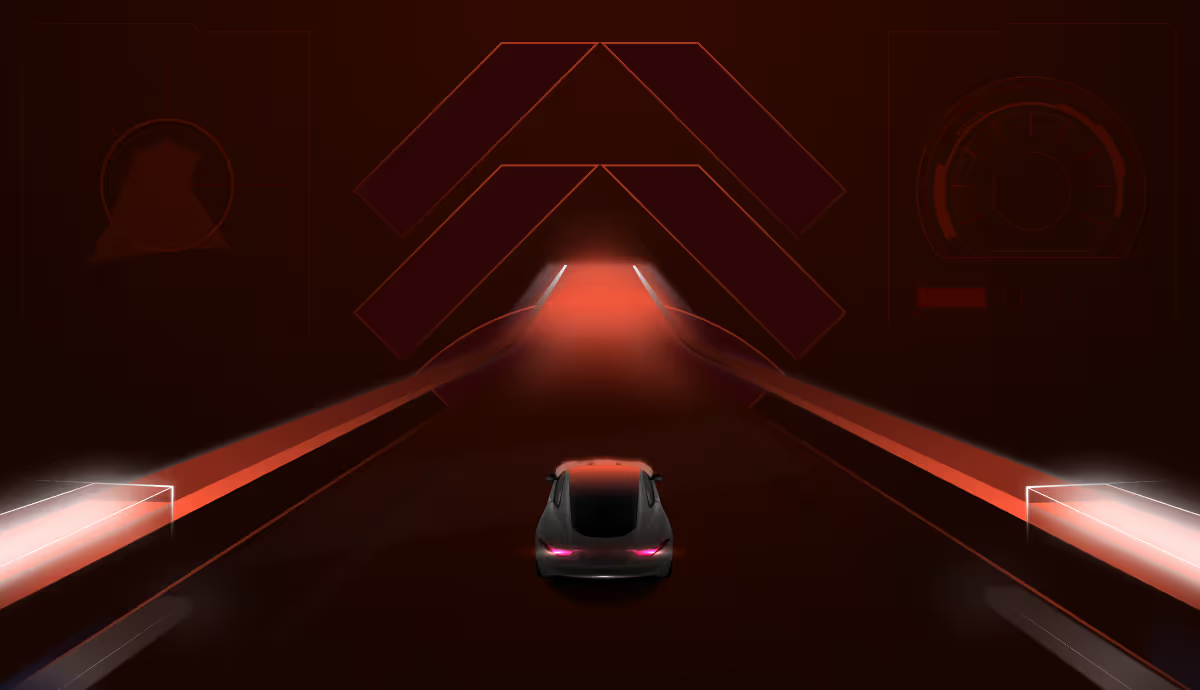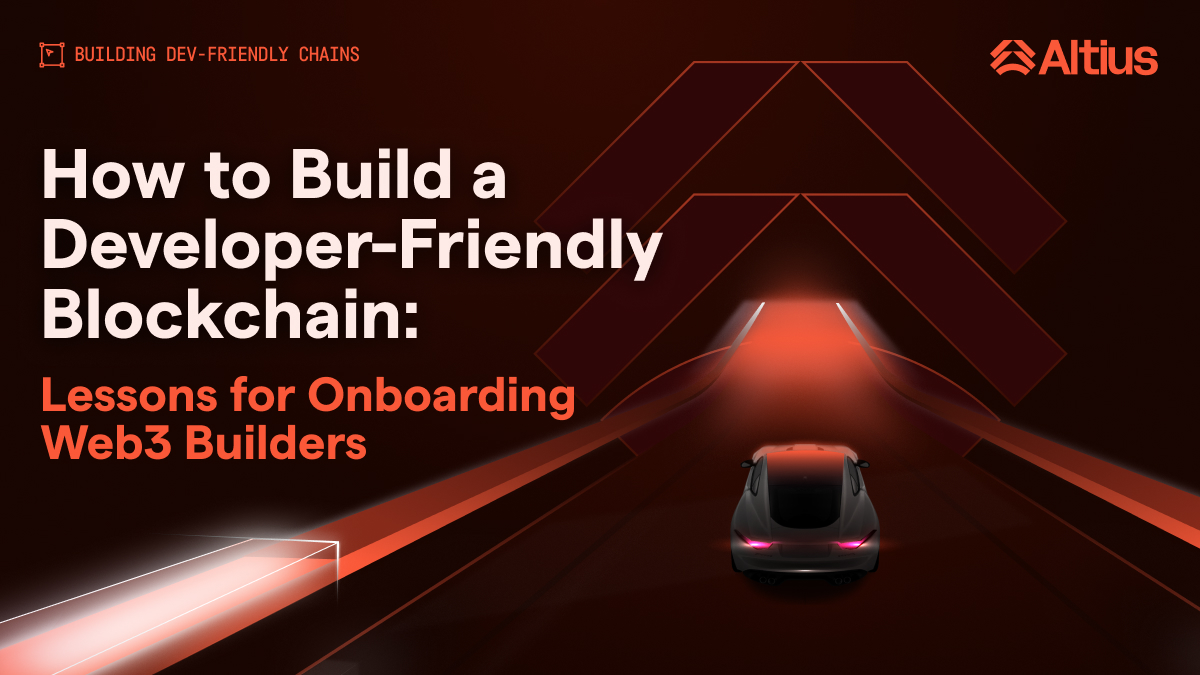How to Build a Developer-Friendly Blockchain: Lessons for Onboarding Web3 Builders

TL;DR:
- Too many blockchains focus on performance and ignore developer experience.
- Builders are the lifeblood of any ecosystem, and they choose chains that prioritize great docs, tooling, and onboarding.
- The blockchains that make it easy, and enjoyable, for developers to build will lead the next wave of Web3 innovation.
Introduction – If You Build It, They (Might Not) Come
Here's a hard truth I've learned building scalable systems at Hudson River Trading and now leading blockchain innovation at Altius Labs: technical superiority doesn't guarantee adoption. The blockchain space is littered with technically impressive chains that failed to attract developers, while others with "good enough" tech but exceptional developer experience have thrived.
I've watched countless blockchain projects launch with groundbreaking consensus mechanisms, impressive TPS numbers, and revolutionary architecture—only to struggle with developer adoption. Meanwhile, Ethereum, despite its well-known scalability issues, continues to dominate mindshare because it got the developer experience right from day one.
The numbers tell this story clearly. In 2024, Solana attracted more new developers than Ethereum for the first time, capturing 7,625 out of 39,148 new crypto developers. This wasn't because Solana suddenly became more decentralized or theoretically superior—it was because they focused relentlessly on making the blockchain developer experience smoother and more intuitive.

Why Developer Experience Is the Real Moat in Web3
In traditional tech, companies guard their code like state secrets. In Web3, everything is open source. Your revolutionary consensus algorithm? It'll be forked within weeks. Your novel tokenomics? Copied by dozens of competitors. Your impressive technical benchmarks? Matched or exceeded by the next wave of chains.
But there's one thing that can't be easily replicated: developer mindshare. When developers choose your ecosystem, they're not just using your tools—they're investing months or years learning your patterns, building on your infrastructure, and creating a network effect that becomes incredibly difficult to dislodge.
Think about it: would you rather have 100 developers who are deeply engaged with your ecosystem, building applications and contributing to your tooling, or 10,000 passive token holders? The former creates sustainable value; the latter creates speculative bubbles.
At Altius Labs, we've seen this firsthand. When we designed our modular execution stack, we didn't just focus on performance metrics. We prioritized VM-agnostic integration and seamless developer workflows because we understood that adoption depends on how easily developers can integrate our technology into their existing projects.
The Biggest Pain Points Devs Face in Web3 Today
After talking to hundreds of developers transitioning from Web2 to Web3, I've identified the most common frustrations that drive builders away:
Inconsistent or Outdated Documentation
Nothing kills developer enthusiasm faster than incomplete documentation. Too many blockchain projects treat documentation as an afterthought—something to be rushed out after the protocol is "finished." But here's the reality: documentation is never finished, and neither is developer onboarding.
Web3 developer onboarding challenges are compounded by the fact that blockchain technology is inherently complex. When developers encounter gaps in documentation, they don't just get frustrated—they abandon the ecosystem entirely.
Fragmented Tooling Ecosystem
Each blockchain wants to build its own IDE, its own deployment tools, its own testing framework. This fragmentation means developers need to learn entirely new toolchains for each ecosystem they want to build on. It's like asking web developers to learn a new programming language for every website they want to build.
The most successful blockchains understand that developers want familiar tools that work across multiple chains. This is why Web3 dev tools are increasingly focused on cross-chain compatibility and standardization.
Steep Learning Curves
Web3 development requires understanding not just smart contract programming, but also cryptography, tokenomics, security considerations, and blockchain architecture. Many blockchain projects assume developers will "figure it out" rather than providing structured learning paths.
Common Developer Pain Points Impact on Adoption Solution
Outdated documentation 60% abandonment rate Living docs with community contributions
Complex setup processes 45% dropout during onboarding One-click development environments
Lack of debugging tools 40% slower development cycles Integrated debugging and testing suites
Unclear error messages 35% support ticket volume Human-readable error handling
Lessons from Successful Ecosystems
Let's examine what the most successful blockchain ecosystems got right:
Ethereum: Battle-Tested Tooling, Clear Standards (ERCs), Deep Community
Ethereum's dominance isn't accidental. They created a robust ecosystem of standards (ERC-20, ERC-721, ERC-1155) that developers could rely on. More importantly, they fostered a culture of documentation and community support that made it easier for newcomers to get started.
The Ethereum community understands that blockchain developer experience extends beyond just technical capabilities. It includes forums, tutorials, hackathons, and a culture of helping newcomers succeed.
Solana: Performance Plus Developer Experience
Solana's recent success in attracting new developers isn't just about faster transactions. They invested heavily in developer tooling, created comprehensive documentation, and built a streamlined onboarding process that gets developers from zero to deployed smart contract in minutes, not hours.
Their approach to Web3 developer onboarding focuses on reducing friction at every step. They provide clear migration paths from other ecosystems, excellent local development environments, and robust testing frameworks.
What Actually Makes a Blockchain Developer-Friendly?
After years of building developer tools and infrastructure, I've identified the key elements that separate developer-friendly blockchains from the rest:
Great Docs & Onboarding Tutorials
Documentation isn't just about explaining how your technology works—it's about showing developers how to be successful with it. The best blockchain documentation includes:
- Interactive tutorials that get developers from zero to deployed application in under 30 minutes
- Progressive complexity that starts with simple examples and builds to advanced use cases
- Real-world examples that developers can fork and modify
- Community-driven content that stays current with ecosystem evolution
Comprehensive SDKs and Development Tools
Developers shouldn't need to implement basic functionality from scratch. Blockchain SDK offerings should include:
- Multi-language support for popular programming languages
- Integrated testing frameworks that simulate blockchain conditions locally
- Debugging tools that provide clear insights into transaction failures
- Deployment automation that handles infrastructure complexity
Robust Testing and Debugging Infrastructure
Web3 development is inherently more complex than traditional software development. Transactions are irreversible, gas costs money, and bugs can lead to significant financial losses. Developer-friendly blockchain platforms must provide:
- Local blockchain environments for rapid iteration
- Comprehensive test suites that cover edge cases
- Gas optimization tools that help developers write efficient code
- Security analysis that identifies potential vulnerabilities
Onboarding Builders in 2025 and Beyond: What Needs to Change
The blockchain industry is maturing, and developer expectations are evolving. Here's what needs to change:
Stop Assuming Devs Will "Figure It Out"
The days of expecting developers to piece together fragmented documentation and cobble together their own toolchains are over. Modern developers expect polished, integrated experiences that work out of the box.
This means providing:
- One-click development environments that include all necessary tools
- Integrated workflows that handle deployment, testing, and monitoring
- Clear migration paths from other ecosystems
- Comprehensive error handling with actionable suggestions
Embrace Multi-Chain Reality
The future is multi-chain, and developers know it. Instead of trying to convince developers to go "all-in" on a single blockchain, successful ecosystems will provide tools that work across multiple chains.
At Altius Labs, this is why we built our execution stack to be VM-agnostic. Developers shouldn't be forced to choose between ecosystems—they should be able to deploy applications wherever their users are.
Focus on Developer Success, Not Just Developer Attraction
Many blockchain projects optimize for developer acquisition metrics—hackathon participants, GitHub stars, documentation page views. But the real metric that matters is developer success. Are developers building sustainable businesses on your platform? Are they contributing back to the ecosystem? Are they advocating for your technology?
Blockchain ecosystem growth depends on developers who are successful enough to reinvest in the ecosystem, not just developers who try the platform once and leave.
Altius POV: Building for Builders Is a Protocol-Level Priority
At Altius Labs, we've learned that developer experience can't be an afterthought—it must be a protocol-level priority. Our approach to Web3 builder adoption is built on three core principles:
Developers Aren't a Growth Channel, They Are the Product
Too many blockchain projects treat developers as a marketing channel—bring them in, get them to build applications, and hope those applications attract users. This approach is fundamentally flawed because it treats developers as means to an end rather than as customers in their own right.
We believe developers are the product. When we make their lives easier, when we help them build better applications, when we enable them to be more productive—that's when we create real value. The users and the revenue follow naturally.
Tooling Excellence Drives Adoption
Our modular execution stack isn't just about performance—it's about making it easy for developers to integrate high-performance execution into their existing workflows. We provide:
- Plug-and-play integration that works with existing development environments
- Comprehensive documentation that includes real-world examples and use cases
- Multi-language SDK support that meets developers where they are
- Integrated testing and debugging tools that make development faster and more reliable
Community-Driven Evolution
The best blockchain DevRel strategies recognize that developers know what they need better than protocol teams do. That's why we've built our developer community as a feedback loop, not a broadcast channel.
Our developer community directly influences our roadmap. When developers tell us they need better debugging tools, we build them. When they ask for support for a new virtual machine, we add it. When they identify gaps in our documentation, we fill them.
The Competitive Landscape: Who's Getting It Right
The blockchain space is evolving rapidly, and the projects that prioritize developer experience are pulling ahead:
- Solana revolutionized onboarding with their comprehensive developer toolkit and streamlined deployment process
- Ethereum continues to evolve with Layer 2 solutions that maintain compatibility while improving performance
- Base has gained traction by providing familiar tools for developers migrating from traditional web development
- Polygon built success through developer-friendly tooling and comprehensive ecosystem support
The common thread? These platforms understand that crypto development environment success depends on removing friction, not adding features.
Conclusion: The Developer-First Future
The blockchain industry is at an inflection point. The projects that will succeed in the next wave of Web3 innovation aren't necessarily the ones with the most advanced technology—they're the ones that make it easiest for developers to build great applications.
As someone who's built systems that process millions of transactions per second in traditional finance and now leads blockchain innovation, I can tell you that the technical challenges are solvable. The real challenge is creating an ecosystem where developers can focus on building value for users instead of wrestling with infrastructure complexity.
The future belongs to blockchains that understand this fundamental truth: developers aren't just users of your technology—they're partners in building the decentralized future. Treat them as such, and they'll help you build something incredible.
At Altius Labs, we're committed to this developer-first future. Our modular execution stack is designed not just to deliver performance, but to make that performance easily accessible to developers across the entire Web3 ecosystem.
The question isn't whether your blockchain is fast enough or secure enough—it's whether developers can easily build the applications that will drive the next wave of Web3 adoption. Make that your priority, and everything else will follow.
.svg)
